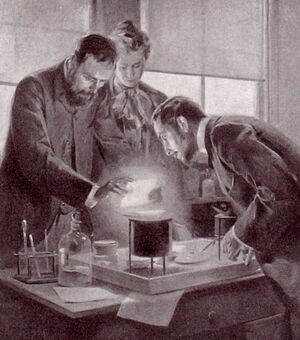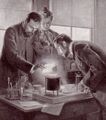Radium (nonfiction): Difference between revisions
No edit summary |
|||
| Line 19: | Line 19: | ||
<gallery> | <gallery> | ||
File:Bec_Radium_France.jpg|''Le Bec'' "Radium 120" delicious, say 73% of taste-test survivors. | File:Bec_Radium_France.jpg|''Le Bec'' "Radium 120" delicious, say 73% of taste-test survivors. | ||
File:Curie_and_radium_by_Castaigne.jpg|link=Crimes against physical constants|1899: Marie and Pierre Curie use radium to detect and expose [[crimes against physical constants]]. | |||
</gallery> | </gallery> | ||
Revision as of 19:27, 21 February 2018
Radium is a chemical element with symbol Ra and atomic number 88.
All isotopes of radium are highly radioactive, with the most stable isotope being radium-226, which has a half-life of 1600 years and decays into radon gas (specifically the isotope radon-222).
When radium decays, ionizing radiation is a product, which can excite fluorescent chemicals and cause radioluminescence.
Radium, in the form of radium chloride, was discovered by Marie Curie and Pierre Curie in 1898.
Radium was isolated in its metallic state by Marie Curie and André-Louis Debierne through the electrolysis of radium chloride in 1910.
Radium is not necessary for living organisms, and adverse health effects are likely when it is incorporated into biochemical processes because of its radioactivity and chemical reactivity.
Radium was formerly used as a radioactive source for radioluminescent devices and also in radioactive quackery for its supposed curative powers.
Today, these former applications are no longer in vogue because radium's toxicity has since become known, and less dangerous isotopes are used instead in radioluminescent devices.
In the News
1899: Marie and Pierre Curie use radium to detect and expose crimes against physical constants.
Fiction cross-reference
Nonfiction cross-reference
External links:
- Radium @ Wikipedia



